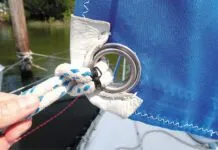Cracked Polyethylene Tanks
I contacted a company called Master Bond, Inc., in Hackensack, New Jersey (201/343-8983). They have an adhesive called X17 they claim works on polyethylene and polypropylene. Unfortunately, the smallest quantity they sell is 1/2 pint for $85.
However, they did give me some valuable information. The X17 is used as a primer, but first the polyethylene has to be heat treated with the blue flame of a propane torch. I tried this without the X17 primer and applied three popular sealants over the area treated: Goop, silicone, epoxy (5 min.). I let them cure over 24 hours. Both the silicone and epoxy seem to adhere very well. Goop could be peeled off with some effort.
At this time I am reluctant to try a repair and reinstall the tank without knowing if it will work for the long term.
Have you found out anything from the tank manufacturers?
Robert P. Weismantel
Ringwood, New Jersey
We asked Ed McKiernan, president of SeaLand Technology, which makes polyethylene tanks, among other things, whether these tanks can be repaired. He said there is no adhesive or caulk that really works well; hence there is no good cure for a cracked poly tank. He did say some field mechanics can fix a leak by going over the crack with a buffing wheel (cloth removed). This apparently creates just enough heat to help close the crack. He also said 3M introduced a product a few years ago that was supposed to seal poly cracks, but it didnt work very well and was withdrawn from the market.
The message we got was: Replace the tank.
Stripe-Tape Removal
I need to replace the tape used to highlight the cove stripe on my boat.Do you have any suggestions for the best way to remove the old tape? Ive tried a 3M product for removing adhesive (suggested by a local marine store), and a friend suggested using a heat gun to soften the adhesive so the old tape can be scraped off. Both seemed to be a very slow process, and I was concerned of the affect of the heat gun on the painted boot stripe just above the stripe.
Sandy McFarland
Via email
In the March 1998 issue we reported on two stripe removers-3Ms Large Area Stripe Eliminator, which sold for $52.98, and the Stripe Eliminator made by Tenco Industries, which sells for $19.95 (see photo at right). On receiving your letter we talked to Tencos Dean Clemente, who said the product sells well. It is also marketed to auto shops for removing pin striping on cars.
Both products are discs that fit into drills and are pressed against the stripe/tape as they spin. We have tested both and they do remove the adhesive residue as well.
We wouldnt use a heat gun on a painted surface as it will cause the paint to blister. Wed also be careful about using it on fiberglass. (LASR, 3M, Marine Trades Bldg., St. Paul, MN 55144; 612/736-2436. Tenco Industries, 35200 Union Lake Rd., Mt.Clemens, MI 48045; 800/343-3776.



































